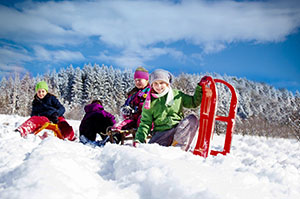Having your kids wear sunglasses when the ground is covered with snow is as important as having them wear them on a summer day at the beach – perhaps even more so. Wearing the right winter sunglasses prevents snow blindness and, more important, helps prevent cataracts in later life.
 1. “Snow blindness” is not exactly a household term. And you need not be lost in the Arctic for it to occur. It happens to the unprotected eyes of infants being carried in backpacks or pushed in strollers, toddlers frolicking in the snow, and older kids out sledding. And while obvious cases are rare and you may never see one, such cases help understand what is happening.
1. “Snow blindness” is not exactly a household term. And you need not be lost in the Arctic for it to occur. It happens to the unprotected eyes of infants being carried in backpacks or pushed in strollers, toddlers frolicking in the snow, and older kids out sledding. And while obvious cases are rare and you may never see one, such cases help understand what is happening.
2. The sun’s rays burn the outer layers of the eyes just as the rays burn the skin. And, as with skin, eye damage occurs each and every time exposure occurs, burning during childhood is particularly injurious, and the damage is cumulative over a lifetime.
3. Snow reflects up to 80% of the sun’s rays. This is a far greater percentage than the reflection from water, sand, cement, grass or dirt. Reflected rays are additive with direct rays. Under the right (or wrong) conditions, snow blindness can occur in a matter of hours.
 4. Outdoor winter activities increase risk. Many take place in snow-covered hilly terrain, allowing reflected rays to hit eyes from all angles. Altitude also increases radiation. Winter resorts tend to be located at higher elevations: the higher the elevation, the less atmosphere to filter out harmful rays. And cold weather, light clouds, and a sun low on the horizon offer little protection. Modern winter clothing allows kids to spend more time outdoors.
4. Outdoor winter activities increase risk. Many take place in snow-covered hilly terrain, allowing reflected rays to hit eyes from all angles. Altitude also increases radiation. Winter resorts tend to be located at higher elevations: the higher the elevation, the less atmosphere to filter out harmful rays. And cold weather, light clouds, and a sun low on the horizon offer little protection. Modern winter clothing allows kids to spend more time outdoors.
5. Recognize the early symptoms of snow blindness. In preverbal kids not wearing sunglasses, beware of excessive blinking or unexplained crankiness. (Frostbite, feeling cold, and too-tight clothing are other possible causes.) Older children complain of eye discomfort, excessive brightness, irritation, dryness, and difficulty blinking. Eyes appear red and teary. These symptoms are often erroneously attributed to wind or cold. Symptoms may appear immediately or after 8 to 12 hours following exposure. Pain and temporary blindness can set in even later.
 6. Ideally, buy sunglasses from eye professionals. Sunglasses are available in supermarkets and elsewhere and may be less expensive there. But in such locations no one helps you select the correct pair for your child. Most summer sunglasses allow too much light to enter the eyes for snow country. You want glasses that offer 100% protection against both UV-A and UV-B radiation, fit snugly, cover the entire area between the eyebrows and middle of the cheeks, and wrap around toward the ears. Wrap-around models prevent rays from entering from the side and help prevent irritation from wind. Large lenses protect from flying ice particles and dirt, and from branches, when skiing and snowmobiling.
6. Ideally, buy sunglasses from eye professionals. Sunglasses are available in supermarkets and elsewhere and may be less expensive there. But in such locations no one helps you select the correct pair for your child. Most summer sunglasses allow too much light to enter the eyes for snow country. You want glasses that offer 100% protection against both UV-A and UV-B radiation, fit snugly, cover the entire area between the eyebrows and middle of the cheeks, and wrap around toward the ears. Wrap-around models prevent rays from entering from the side and help prevent irritation from wind. Large lenses protect from flying ice particles and dirt, and from branches, when skiing and snowmobiling.
7. Hats, scarves and sunscreen complete protection. The sun is frequently overlooked as a cause of eyelid problems. The skin of the eyelids is sensitive, thin and burns easily. Hats with brims at least three inches wide help minimize sunrays from reaching the eyes and eyelids. Scarves help protect the neck. Apply sunscreen to any skin that remains exposed.
 8. Insist that children wear sunglasses. Be firm. Make no exceptions. In fact, most infants and toddlers enjoy wearing them. Make it a treat for them to see their surroundings in different colors. Let them pick out styles. Set a good example by wearing sunglasses yourself.
8. Insist that children wear sunglasses. Be firm. Make no exceptions. In fact, most infants and toddlers enjoy wearing them. Make it a treat for them to see their surroundings in different colors. Let them pick out styles. Set a good example by wearing sunglasses yourself.
9. Know how to treat snow blindness. When symptoms occur outside, get out of the sun. If shelter is unavailable, place a loosely woven scarf, sweater or ski hat over the eyes. Relieve discomfort with cold compresses, ibuprofen (Motrin, Advil) or acetaminophen (Tylenol), a dark environment, and appropriate eye drops. Seek medical help, if necessary.
10. Virtually all cases of snow blindness heal spontaneously over a few days. And there are no immediate visible after effects – just as there are no immediate after affects from everyday sun exposure. But damage occurs and is permanent. It becomes apparent as reduced visibility decades later.

